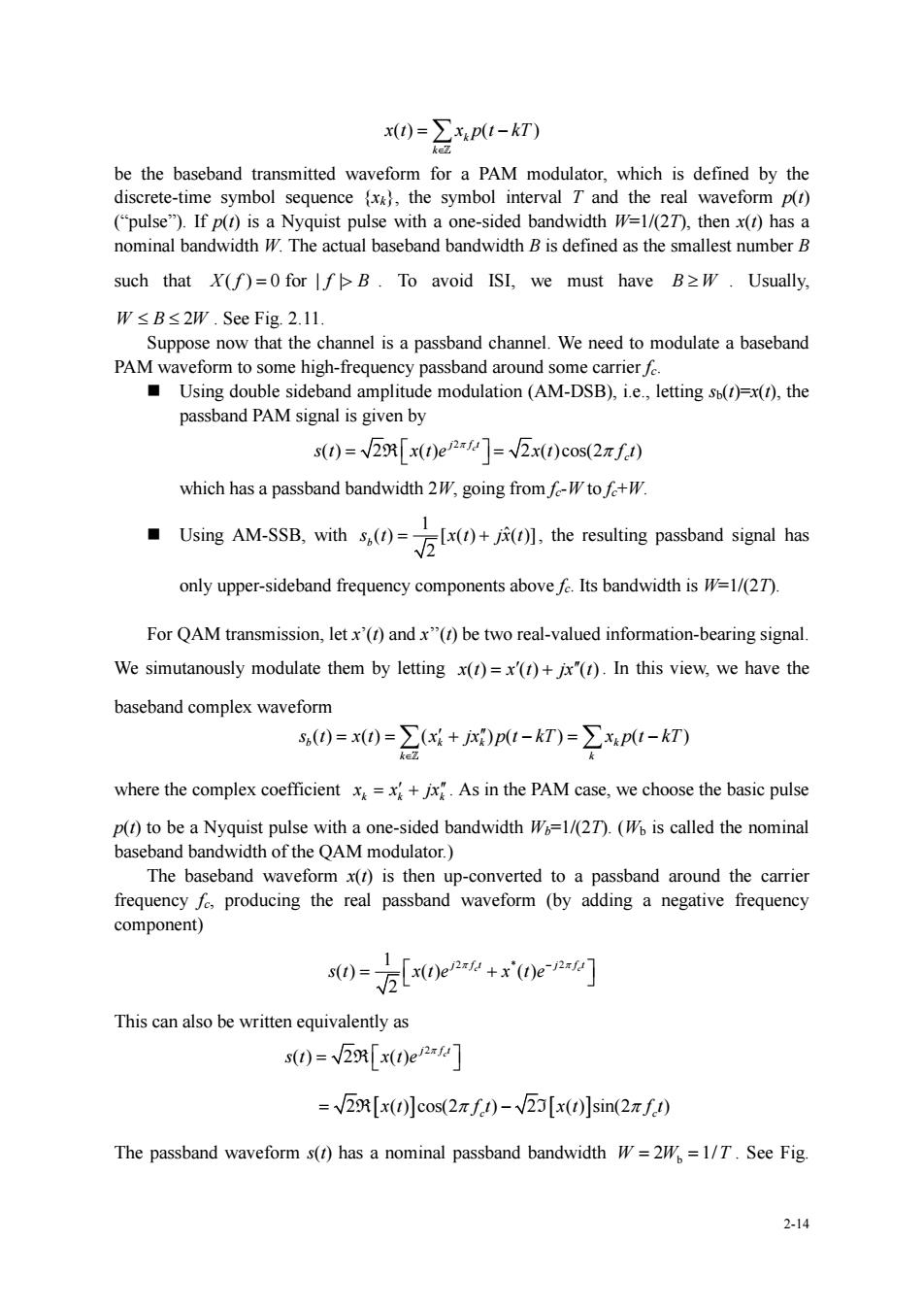正在加载图片...

0=∑-k灯) be the baseband transmitted waveform for a PAM modulator,which is defined by the discrete-time symbol sequencex,the symbol interval T and the real waveform p() ("pulse").If p(r)is a Nyquist pulse with a one-sided bandwidth W=1/(27).then x(t)has a nominal bandwidth W.The actual baseband bandwidth B is defined as the smallest number B such that (f)=0 forfB.To avoid ISI,we must have B2W.Usually, W≤B≤2IW.See Fig.2.1l Suppose now that the channel is a passband channel.We need to modulate a baseband PAM waveform to some high-frequency passband around some carrier fe. Using double sideband amplitude modulation (AM-DSB).ie letting s()=x(t).the passband PAM signal is given by s()=[x(D)e]x()cos(2zf) which has a passband bandwidth 2W,going from fW to f+W. Using AM-SSB,with s,(r)= the resulting passband signal has 1 only upper-sideband frequency components abovef.Its bandwidth is W=1/(27). For QAM transmission,let x'(r)and x"(t)be two real-valued information-bearing signal. We simutanously modulate them by letting x()=x()+x().In this view,we have the baseband complex waveform s()=x()=∑(x+jx)p1-kT)=∑xp1-kT) where the complex coefficient+x As in the PAM case,we choose the basic pulse ()to be a Nyquist pulse with a one-sided bandwidth W1/(2T).is called the nominal baseband bandwidth of the QAM modulator.) The baseband waveform x(r)is then up-converted to a passband around the carrier frequency f producing the real passband waveform (by adding a negative frequency component) This can also be written equivalently as s()=x()e =V2R[x]cos(2πf)-V2[x]sin(2πf) The passband waveform s(t)has a nominal passband bandwidth W=2W=1/T.See Fig. 2-14 2-14 ( ) ( ) k k x t x p t kT = − be the baseband transmitted waveform for a PAM modulator, which is defined by the discrete-time symbol sequence {xk}, the symbol interval T and the real waveform p(t) (“pulse”). If p(t) is a Nyquist pulse with a one-sided bandwidth W=1/(2T), then x(t) has a nominal bandwidth W. The actual baseband bandwidth B is defined as the smallest number B such that X f f B ( ) 0 for | | = . To avoid ISI, we must have B W . Usually, W B W 2 . See Fig. 2.11. Suppose now that the channel is a passband channel. We need to modulate a baseband PAM waveform to some high-frequency passband around some carrier fc. ◼ Using double sideband amplitude modulation (AM-DSB), i.e., letting sb(t)=x(t), the passband PAM signal is given by 2 ( ) 2 ( ) 2 ( )cos(2 ) c j f t c s t x t e x t f t = = R which has a passband bandwidth 2W, going from fc-W to fc+W. ◼ Using AM-SSB, with 1 ( ) [ ( ) ( )] ˆ 2 b s t x t jx t = + , the resulting passband signal has only upper-sideband frequency components above fc. Its bandwidth is W=1/(2T). For QAM transmission, let x’(t) and x’’(t) be two real-valued information-bearing signal. We simutanously modulate them by letting x t x t jx t ( ) ( ) ( ) = + . In this view, we have the baseband complex waveform ( ) ( ) ( ) ( ) ( ) b k k k k k s t x t x jx p t kT x p t kT = = + − = − where the complex coefficient k k k x x jx = + . As in the PAM case, we choose the basic pulse p(t) to be a Nyquist pulse with a one-sided bandwidth Wb=1/(2T). (Wb is called the nominal baseband bandwidth of the QAM modulator.) The baseband waveform x(t) is then up-converted to a passband around the carrier frequency fc, producing the real passband waveform (by adding a negative frequency component) 1 2 2 * ( ) ( ) ( ) 2 c c j f t j f t s t x t e x t e − = + This can also be written equivalently as 2 ( ) 2 ( ) c j f t s t x t e = R = − 2 ( ) cos(2 ) 2 ( ) sin(2 ) R I x t f t x t f t c c The passband waveform s(t) has a nominal passband bandwidth b W W T = = 2 1/ . See Fig